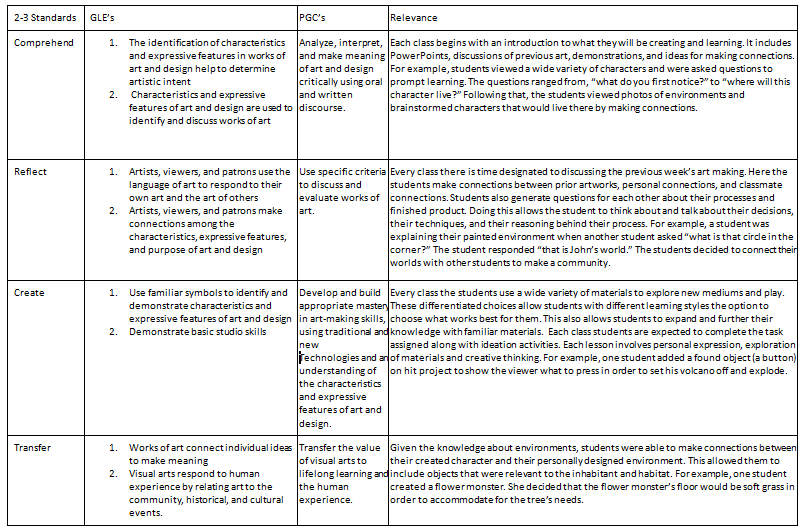Unit Topic & Rationelle
This unit focuses on architecture and the characteristics and expressive features involved. We will be learning about different spaces and things that occupy that space. This unit was created after our first lesson of getting to know the students. Many students made it apparent that they were interested in environments, characters, and stories. This unit consists of 3 lessons that are described below:
Lesson 1: Lesson 1 focuses on the students creating a character/creature. Several topics were introduced to the students such as planning, ideation, artistic expression, and the artistic process. Students learned basic clay techniques including coil building, slipping and scoring, and pinch pots. They were also presented with basic clay tools including an extruder, loop tools, and forks for scratching.
Lesson 2: Lesson 2 focuses on students creating a space for their character/creature to live in. This lesson’s goal was to create a painting depicting space. Students used, ideation, paint, and found materials to create their painting. Students focused on color mixing, space, line, artistic process, and artistic intention. They were introduced to the tools of paint brushes and found materials.
Lesson 3: Lesson 3 focuses on creating a 3-D model of their space and then building a city. The goal of this lesson is to create a model of the space that their character will inhibit. The students will then take their environments and collaborate with other students to create their own city. This lesson focuses on space, line, scale, modeling, transferring, and making connections. Students will be presented with the art of sculpture and using found objects. They will be manipulating found objects into new items.
Significance of Topic:
Globally: Our architecture unit allowed students to explore the relationship of habitat and inhabitant. They were able to make connections and understand how the habitat reflects the inhabitant. This can be explored at a much higher level and can help students make other relationships in the real world. Students also had the opportunity to explore a variety of materials and work cooperatively with others which contributes to life-long skills that the arts teach.
Personally: This topic is significant to my group because we all come from different artistic backgrounds. We wanted to create a unit that gave us all the opportunity to share our skills with the students. We were also drawn to this unit for the variety of work that we hoped to receive from our students.
For This Population: The idea of architecture may seem like a lot to a 3rd grader but we have simplified the concept into something that the students can relate to. The ides for this lesson blossomed from the students and their love to create creatures and characters. They were very engaged in storytelling and giving their character a context so we wanted to allow them to be creative with this. We also wanted to give them a variety of materials to explore since they are all very curious in intrigued by art.
Lesson 1: Lesson 1 focuses on the students creating a character/creature. Several topics were introduced to the students such as planning, ideation, artistic expression, and the artistic process. Students learned basic clay techniques including coil building, slipping and scoring, and pinch pots. They were also presented with basic clay tools including an extruder, loop tools, and forks for scratching.
Lesson 2: Lesson 2 focuses on students creating a space for their character/creature to live in. This lesson’s goal was to create a painting depicting space. Students used, ideation, paint, and found materials to create their painting. Students focused on color mixing, space, line, artistic process, and artistic intention. They were introduced to the tools of paint brushes and found materials.
Lesson 3: Lesson 3 focuses on creating a 3-D model of their space and then building a city. The goal of this lesson is to create a model of the space that their character will inhibit. The students will then take their environments and collaborate with other students to create their own city. This lesson focuses on space, line, scale, modeling, transferring, and making connections. Students will be presented with the art of sculpture and using found objects. They will be manipulating found objects into new items.
Significance of Topic:
Globally: Our architecture unit allowed students to explore the relationship of habitat and inhabitant. They were able to make connections and understand how the habitat reflects the inhabitant. This can be explored at a much higher level and can help students make other relationships in the real world. Students also had the opportunity to explore a variety of materials and work cooperatively with others which contributes to life-long skills that the arts teach.
Personally: This topic is significant to my group because we all come from different artistic backgrounds. We wanted to create a unit that gave us all the opportunity to share our skills with the students. We were also drawn to this unit for the variety of work that we hoped to receive from our students.
For This Population: The idea of architecture may seem like a lot to a 3rd grader but we have simplified the concept into something that the students can relate to. The ides for this lesson blossomed from the students and their love to create creatures and characters. They were very engaged in storytelling and giving their character a context so we wanted to allow them to be creative with this. We also wanted to give them a variety of materials to explore since they are all very curious in intrigued by art.

